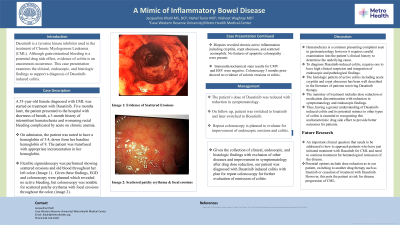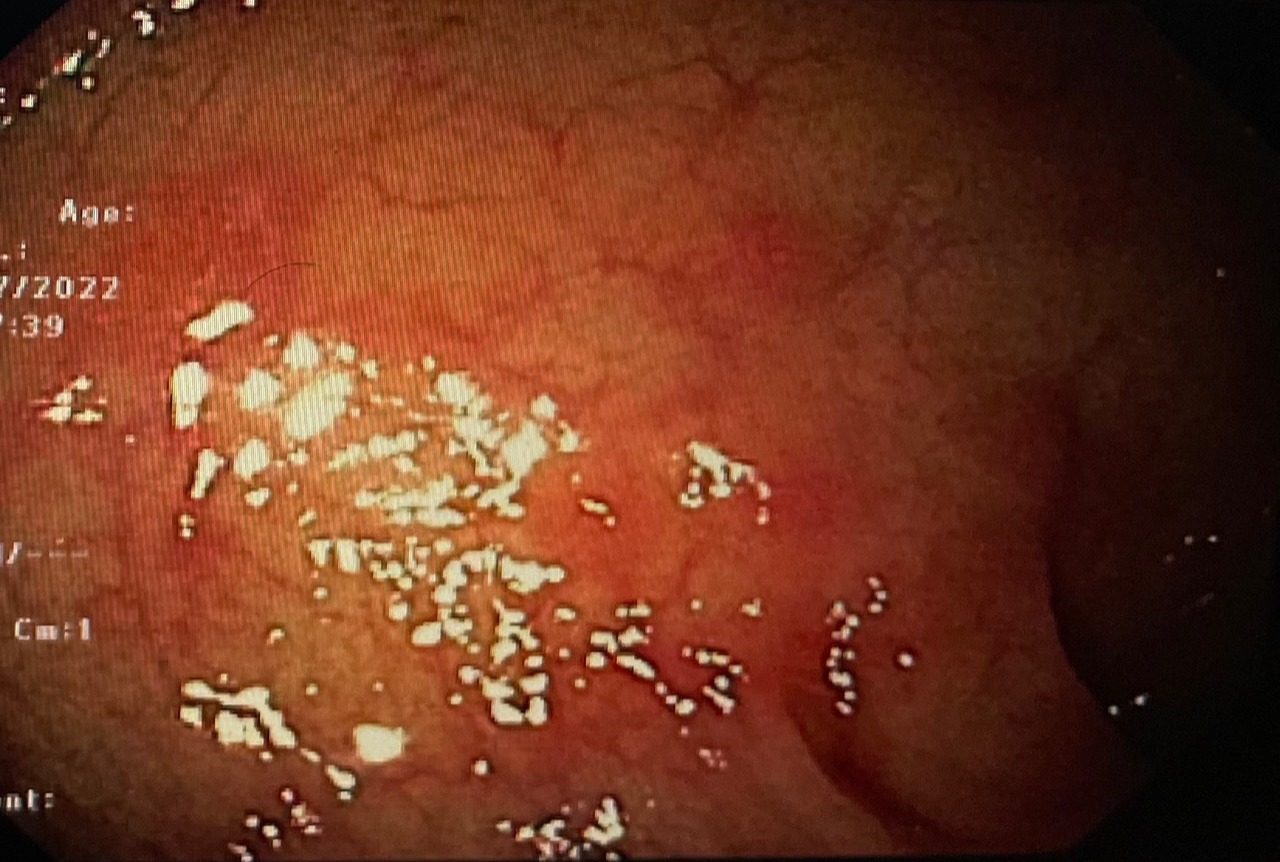Sunday Poster Session
Category: IBD
P0822 - A Mimic of Inflammatory Bowel Disease
Sunday, October 22, 2023
3:30 PM - 7:00 PM PT
Location: Exhibit Hall

Has Audio

Jacqueline Khalil, DO, MS
Case Western Reserve University/Metro Health
Cleveland, OH
Presenting Author(s)
Jacqueline Khalil, DO, MS, Nahel A. Tunio, MD, Nisheet Waghray, MD
Case Western Reserve University/Metro Health, Cleveland, OH
Introduction: Dasatinib is a tyrosine kinase inhibitor used in the treatment of Chronic Myelogenous Leukemia (CML). Although gastrointestinal bleeding is a potential drug side effect, evidence of colitis is an uncommon occurrence. This case presentation examines the clinical, endoscopic, and histologic findings to support a diagnosis of Dasatinib-induced colitis.
Case Description/Methods: A 53-year-old female diagnosed with CML was started on treatment with Dasatinib. 5 months later, the patient presented with intermittent hematochezia and rectal bleeding complicated by acute on chronic anemia. The patient was noted to have a hemoglobin of 5.4, down from her baseline hemoglobin of 8. The patient was transfused with appropriate incrementation. Flexible sigmoidoscopy was performed showing scattered erosions and old blood throughout her left colon. Given these findings, EGD and colonoscopy were planned which revealed no active bleeding, but colonoscopy was notable for scattered patchy erythema with focal erosions throughout the colon (image1). Biopsies revealed chronic active inflammation including cryptitis, crypt abscesses, and scattered eosinophils. No features of apoptotic colonopathy were present. Immunohistochemical stain results for CMV and HSV were negative. Colonoscopy 3 months prior showed no evidence of colonic erosions or colitis. The patient’s dose of Dasatinib was reduced with reduction in symptomatology. Repeat colonoscopy is planned to evaluate for improvement of endoscopic erosions and colitis.
Discussion: Given the collection of clinical, endoscopic, and histologic findings with exclusion of other diseases and improvement in symptomatology after drug dose reduction, our patient was diagnosed with Dasatinib induced colitis. Hematochezia requires careful examination into the patient’s clinical history to determine the underlying cause. To diagnose Dasatinib-induced colitis, requires one to have high clinical suspicion and integration of endoscopic and pathological findings. The histologic pattern of active colitis including acute cryptitis and crypt abscesses has been well described in the literature of patients receiving Dasatinib therapy. The mainstay of treatment includes dose reduction or medication discontinuation with reduction in symptomatology and endoscopic findings. Having a greater understanding of Dasatinib-induced colitis and its potential mimics to other types of colitis is essential to recognizing this uncharacteristic drug side effect to provide better outcomes for patients.

Disclosures:
Jacqueline Khalil, DO, MS, Nahel A. Tunio, MD, Nisheet Waghray, MD. P0822 - A Mimic of Inflammatory Bowel Disease, ACG 2023 Annual Scientific Meeting Abstracts. Vancouver, BC, Canada: American College of Gastroenterology.
Case Western Reserve University/Metro Health, Cleveland, OH
Introduction: Dasatinib is a tyrosine kinase inhibitor used in the treatment of Chronic Myelogenous Leukemia (CML). Although gastrointestinal bleeding is a potential drug side effect, evidence of colitis is an uncommon occurrence. This case presentation examines the clinical, endoscopic, and histologic findings to support a diagnosis of Dasatinib-induced colitis.
Case Description/Methods: A 53-year-old female diagnosed with CML was started on treatment with Dasatinib. 5 months later, the patient presented with intermittent hematochezia and rectal bleeding complicated by acute on chronic anemia. The patient was noted to have a hemoglobin of 5.4, down from her baseline hemoglobin of 8. The patient was transfused with appropriate incrementation. Flexible sigmoidoscopy was performed showing scattered erosions and old blood throughout her left colon. Given these findings, EGD and colonoscopy were planned which revealed no active bleeding, but colonoscopy was notable for scattered patchy erythema with focal erosions throughout the colon (image1). Biopsies revealed chronic active inflammation including cryptitis, crypt abscesses, and scattered eosinophils. No features of apoptotic colonopathy were present. Immunohistochemical stain results for CMV and HSV were negative. Colonoscopy 3 months prior showed no evidence of colonic erosions or colitis. The patient’s dose of Dasatinib was reduced with reduction in symptomatology. Repeat colonoscopy is planned to evaluate for improvement of endoscopic erosions and colitis.
Discussion: Given the collection of clinical, endoscopic, and histologic findings with exclusion of other diseases and improvement in symptomatology after drug dose reduction, our patient was diagnosed with Dasatinib induced colitis. Hematochezia requires careful examination into the patient’s clinical history to determine the underlying cause. To diagnose Dasatinib-induced colitis, requires one to have high clinical suspicion and integration of endoscopic and pathological findings. The histologic pattern of active colitis including acute cryptitis and crypt abscesses has been well described in the literature of patients receiving Dasatinib therapy. The mainstay of treatment includes dose reduction or medication discontinuation with reduction in symptomatology and endoscopic findings. Having a greater understanding of Dasatinib-induced colitis and its potential mimics to other types of colitis is essential to recognizing this uncharacteristic drug side effect to provide better outcomes for patients.

Figure: Scattered patchy erythema with focal erosions on colonoscopy
Disclosures:
Jacqueline Khalil indicated no relevant financial relationships.
Nahel Tunio indicated no relevant financial relationships.
Nisheet Waghray indicated no relevant financial relationships.
Jacqueline Khalil, DO, MS, Nahel A. Tunio, MD, Nisheet Waghray, MD. P0822 - A Mimic of Inflammatory Bowel Disease, ACG 2023 Annual Scientific Meeting Abstracts. Vancouver, BC, Canada: American College of Gastroenterology.
